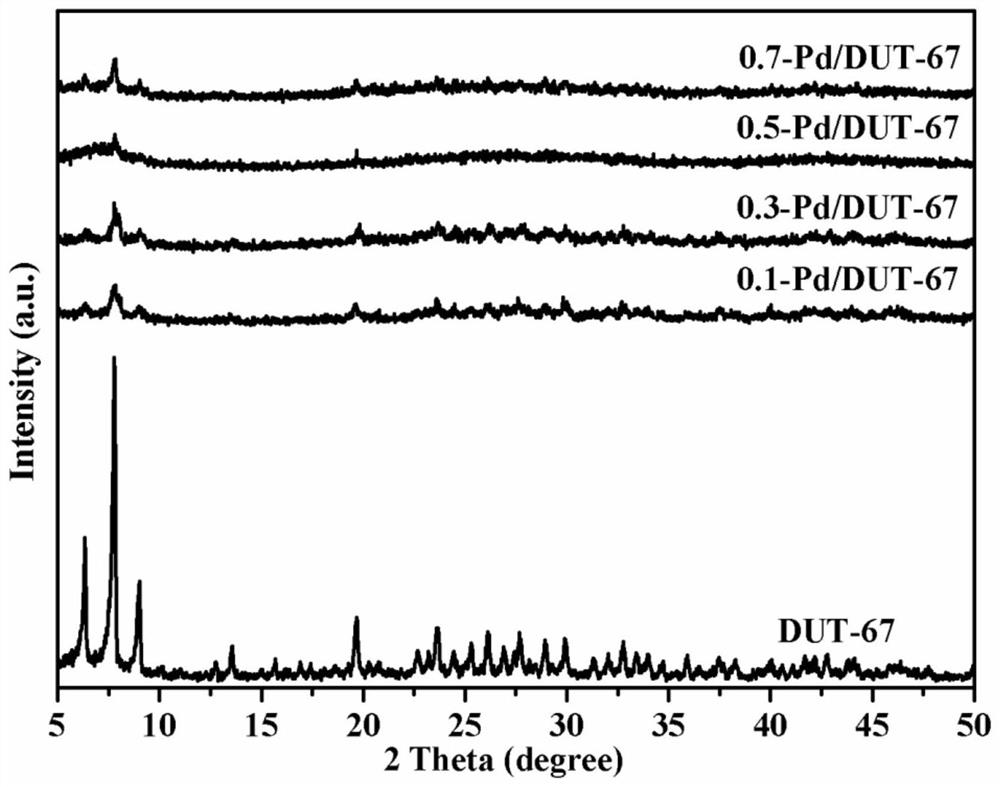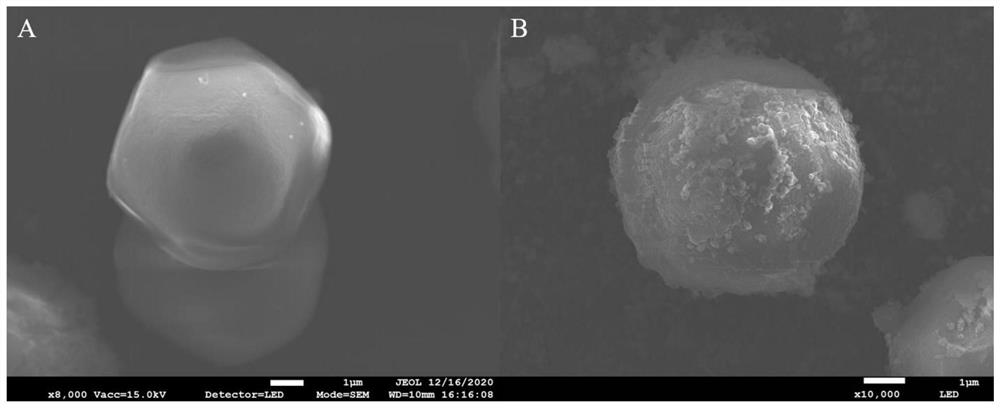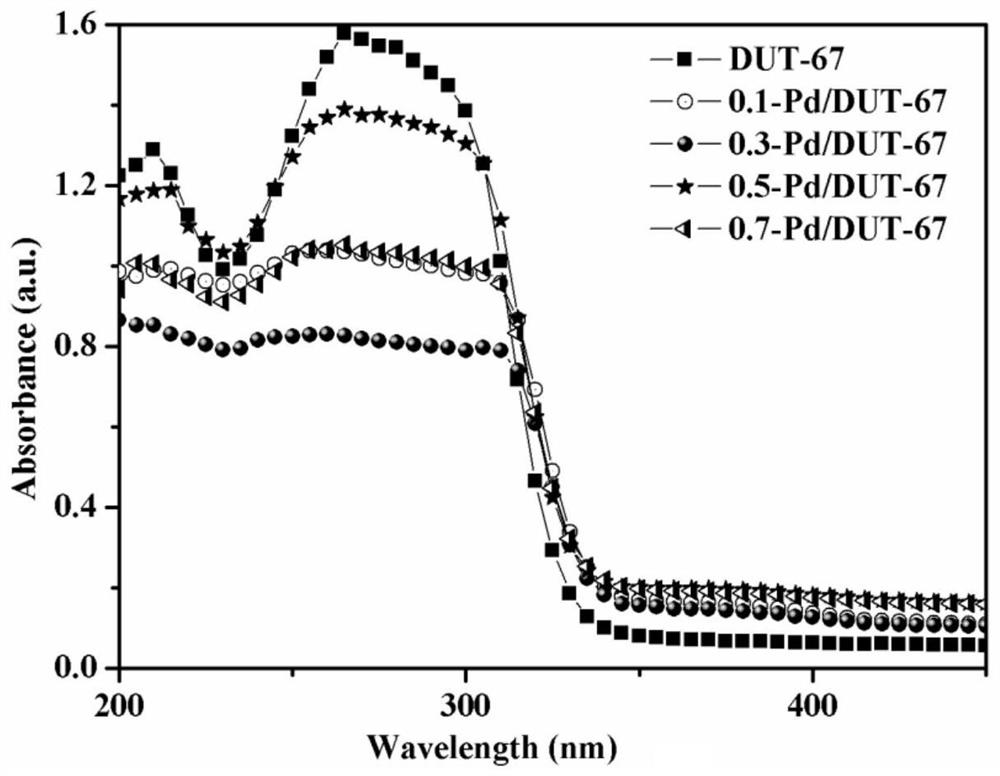Preparation method and application of plasmonic composite photocatalyst pd/dut-67
A technology of DUT-67 and plasmons, which is applied in the field of preparation of ion polariton composite photocatalyst Pd/DUT-67, can solve the problem that the catalytic active sites cannot be fully utilized, the catalytic efficiency is limited, and the light utilization rate is low. problem, to achieve the effect of improving photoreduction ability, improving adsorption performance, and improving transmission ability
- Summary
- Abstract
- Description
- Claims
- Application Information
AI Technical Summary
Problems solved by technology
Method used
Image
Examples
Embodiment 1
[0031](1) Preparation of DUT-67:
[0032] Dissolve 0.5 mmol of zirconium chloride in a mixed solution of 6.25 mL of N,N-dimethylformamide and 6.25 mL of N-methylpyrrolidone, add 0.34 mmol of 2,5-thiophenedicarboxylic acid and sonicate until dissolved , 3.5 mL of acetic acid was added, then the mixture was transferred to a Teflon-lined autoclave and kept at 120 °C for 24 h. A white product was obtained by centrifugation, washed with N,N-dimethylformamide until the solution was colorless, washed three times with methanol, and dried under vacuum at 120° C. for 12 hours.
[0033] (2) Preparation of Pd nanosheets:
[0034] Weigh 26.6 mg of palladium chloride and 871.3 mg of potassium iodide into a round-bottomed flask, add 1 mL of H 2 O, stir well to dissolve completely, forming a dark red solution. Before the reaction, 9.0 mL of tetraethylene glycol was quickly added, and then 160 mg of polyvinylpyrrolidone was added, and the mixture was stirred until the polyvinylpyrrolidone w...
Embodiment 2
[0039] (1) Preparation of DUT-67:
[0040] Dissolve 0.5 mmol of zirconium chloride in a mixed solution of 6.25 mL of N,N-dimethylformamide and 6.25 mL of N-methylpyrrolidone, add 0.34 mmol of 2,5-thiophenedicarboxylic acid and sonicate until dissolved , 3.5 mL of acetic acid was added, then the mixture was transferred to a Teflon-lined autoclave and kept at 120 °C for 24 h. A white product was obtained by centrifugation, washed with N,N-dimethylformamide until the solution was colorless, washed three times with methanol, and dried under vacuum at 120° C. for 12 hours.
[0041] (2) Preparation of Pd nanosheets:
[0042] Weigh 26.6 mg of palladium chloride and 871.3 mg of potassium iodide into a round-bottomed flask, add 1 mL of H 2 O, stir well to dissolve completely, forming a dark red solution. Before the reaction, 9.0 mL of tetraethylene glycol was quickly added, and then 160 mg of polyvinylpyrrolidone was added, and the mixture was stirred until the polyvinylpyrrolidone ...
Embodiment 3
[0047] (1) Preparation of DUT-67:
[0048] Dissolve 0.5 mmol of zirconium chloride in a mixed solution of 6.25 mL of N,N-dimethylformamide and 6.25 mL of N-methylpyrrolidone, add 0.34 mmol of 2,5-thiophenedicarboxylic acid and sonicate until dissolved , 3.5 mL of acetic acid was added, then the mixture was transferred to an autoclave with Teflon and kept at 120 °C for 24 h. A white product was obtained by centrifugation, washed with N,N-dimethylformamide until the solution was colorless, washed three times with methanol, and dried under vacuum at 120° C. for 12 hours.
[0049] (2) Preparation of Pd nanosheets:
[0050] Weigh 26.6 mg of palladium chloride and 871.3 mg of potassium iodide into a round-bottomed flask, add 1 mL of H 2 O, stir well to dissolve completely, forming a dark red solution. Before the reaction, 9.0 mL of tetraethylene glycol was quickly added, and then 160 mg of polyvinylpyrrolidone was added, and the mixture was stirred until the polyvinylpyrrolidone ...
PUM
 Login to View More
Login to View More Abstract
Description
Claims
Application Information
 Login to View More
Login to View More - R&D
- Intellectual Property
- Life Sciences
- Materials
- Tech Scout
- Unparalleled Data Quality
- Higher Quality Content
- 60% Fewer Hallucinations
Browse by: Latest US Patents, China's latest patents, Technical Efficacy Thesaurus, Application Domain, Technology Topic, Popular Technical Reports.
© 2025 PatSnap. All rights reserved.Legal|Privacy policy|Modern Slavery Act Transparency Statement|Sitemap|About US| Contact US: help@patsnap.com



